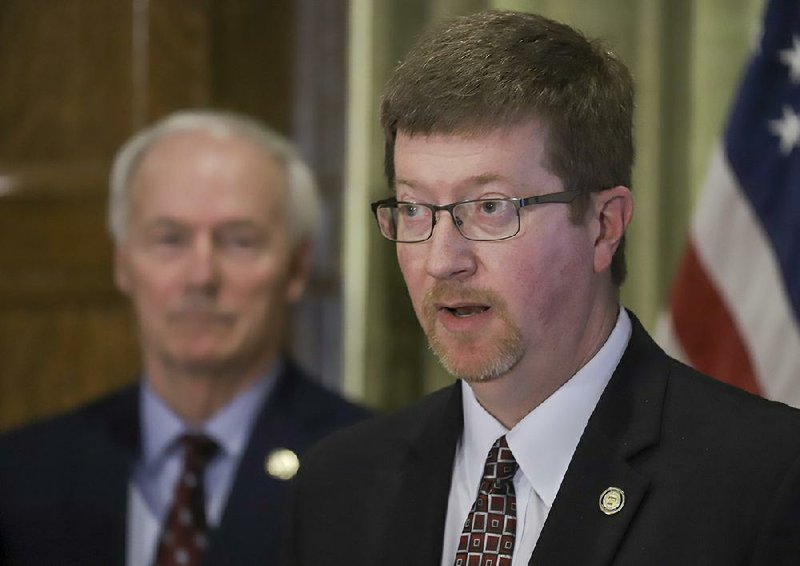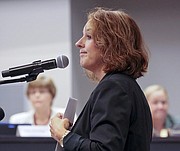The Arkansas Division of Elementary and Secondary Education on Thursday directed Arkansas school districts to prepare an education program for the coming school year that relies on face-to-face and online instruction with the flexibility to blend them and to pivot from one to the other.
In an online webinar to introduce school and district leaders to the state's newly released Arkansas Ready for Learning guide, top-level education agency staff members called for the school systems to begin right away to identify digital lessons and diagnostic tests to use in the 2020-21 school year.
The agency leaders, who offered a range of resources to help the districts, also called for providing computer devices and internet access to students and faculty members, identifying waivers of state laws and rules they will need on a fast track to carry out a blended instruction program, formulating communication plans and modifying their own district policies.
"As many of you have heard the governor state, it is his expectation and desire that we in Arkansas start back to school in August as normal as possible," Arkansas Education Secretary Johnny Key said. "However, we know that in this covid-19 situation that some of those things that we once considered normal will definitely need adjustments," he also said in offering the Arkansas Ready for Learning guide.
The state's plans for the 2020-21 school year come in the midst of the covid-19 pandemic that caused Arkansas Gov. Asa Hutchinson to close campuses to 470,000 public school students in March for what turned out to be the rest of the 2019-20 school year. Students and teachers did schoolwork from home, using paper packets and online lessons, although that was sometimes hindered by a lack of computer devices and/or internet connections in some homes.
The guidebook, which is now on the division's website, suggests tasks to be done in six broad areas of operation before classes start in August and then after school starts.
The areas include academics, human capital, student support communication, stakeholder communication, fiscal governance, and facilities and transportation.
Ivy Pfeffer, the state's deputy education commissioner, said Wednesday that a flexible, blended program to teach grade-level material is needed "for our students who we know can learn at any time, anywhere, if given the right supports."
ON-SITE LEARNING
Mike Hernandez, the state's superintendent for intensive support and services, acknowledged that there are many unanswered questions about the reopening of schools, but that updated information will be forthcoming.
He also said that not all of the state Department of Health guidelines for physical distancing to contain the spread of covid-19 will be feasible in all school and school bus situations, but that other precautions such as the wearing of face masks can be used.
One of the first tasks for districts to do this summer, Hernandez said, is form local Ready for Learning committees whose members have specialized skills to address each of the areas of district operations and can coordinate the return to on-site student instruction and monitor as situations change throughout the school year.
Another immediate task is to select someone to be a point of contact to answer questions about covid-19 and serve as a liaison between a school district and state education and health agencies.
Stacy Smith, assistant commissioner for learning services, described the expectations for an instructional program that combined traditional face-to-face instruction and the use of technology and learning management systems in which lessons can be created and/or uploaded by teachers, completed by students, and then graded and recorded by the teachers.
"When we think about what blended learning looks like in our state and in the future, every district is going to be a little different," Smith said. "The expectation is that all districts have started moving toward some type of blended learning approach. That includes face-to-face and also digital-based instruction.
"The expectation is that all districts will have some type of a learning management system in place for their students.
"All districts will also have digital content aligned to grade-level standards," Smith also said, adding that the digital content may be homemade -- created by teachers in the district -- or it may be produced by vendors or built in to the online learning management systems.
"Your district must be able, at any time, to get lessons into the hands of students," she said.
Districts also must continue their efforts to get computer devices and internet connectivity to students, Smith also said.
The state will use some of the $128 million it is receiving from the federal Coronavirus Aid, Relief, and Economic Security Act to offer digital content for grades kindergarten through 12, Smith said. The state will provide that for all school systems in the state, but school districts don't have to use it or they can use it to supplement or accelerate their own digital materials.
"If you don't have anything and you need a place to start, I highly recommend you start here," she said about the online material that will be purchased from an education company.
In the final quarter of this just-ended school year, teachers were encouraged to focus on reviewing previously taught lessons in English/language arts and math with their students rather than introducing new concepts.
Smith said that can't be the practice going forward. New skills and content must be taught in all the core academic subjects and career technical education.
The state will provide districts with the option to expand diagnostic testing of student skills beyond the existing diagnostic testing now done three times a year in kindergarten through second grade. The state will provide testing to track student progress throughout a school year for kindergarten through eighth grade, Smith said. In Arkansas, iStation, iReady, NWEA and Renaissance are the testing programs used to provide almost immediate results.
WAIVER PROVISIONS
Courtney Salas-Ford, an attorney for the Elementary and Secondary Education Division, said school districts will need flexibility in regard to state law and rules in an effort to provide a blended instructional program.
Using legal waivers obtained by districts that are already using blended learning as a guide, the state agency has identified waivers that will be needed to accomplish the vision of the blended-learning model -- while also doing what is best for students and protecting staff, Salas-Ford said.
She cited as an example of a possible waiver the requirement for a traditional six-hour instructional school day.
"We know under a blended model with virtual options, that's just not going to work," she said.
State law already allows traditional districts and charter schools to obtain waivers of some state education laws and rules. But the process includes multiple steps, including approval from the local school board as well as getting input from other stakeholders. Provisions of the Ready for Learning plan -- which will be reviewed by the Arkansas Board of Education at its June 13 meeting -- envisions suspending many of the Act 1240 steps. That would be authorized by a governor's executive order.
"Instead we will have a streamlined process whereby a district that is interested can complete and sign an assurance and application document. Those applications will be due by June 26," Salas-Ford said, adding that those districts that apply will be in essence seeking waivers that have been identified by the state agency as necessary to implement blended learning.
The applications will be submitted to the state Education Board and approved "on the condition that the districts agree to include certain requirements in their district support plans," which are due Sept. 1. The support plans must be posted on each district's website.
"The waivers are just what are needed to implement the blended learning model," Salas-Ford said. "They will be narrowly tailored to that and in some cases have additional limitations on them."
For many of the districts, the waivers would create the need for modifications to a district's school board-approved policies. The Arkansas School Board Association has drafted a resolution that will enable school boards to modify or suspend their policies that are in conflict or not consistent with the approved waivers, she said.
A Section on 06/05/2020


